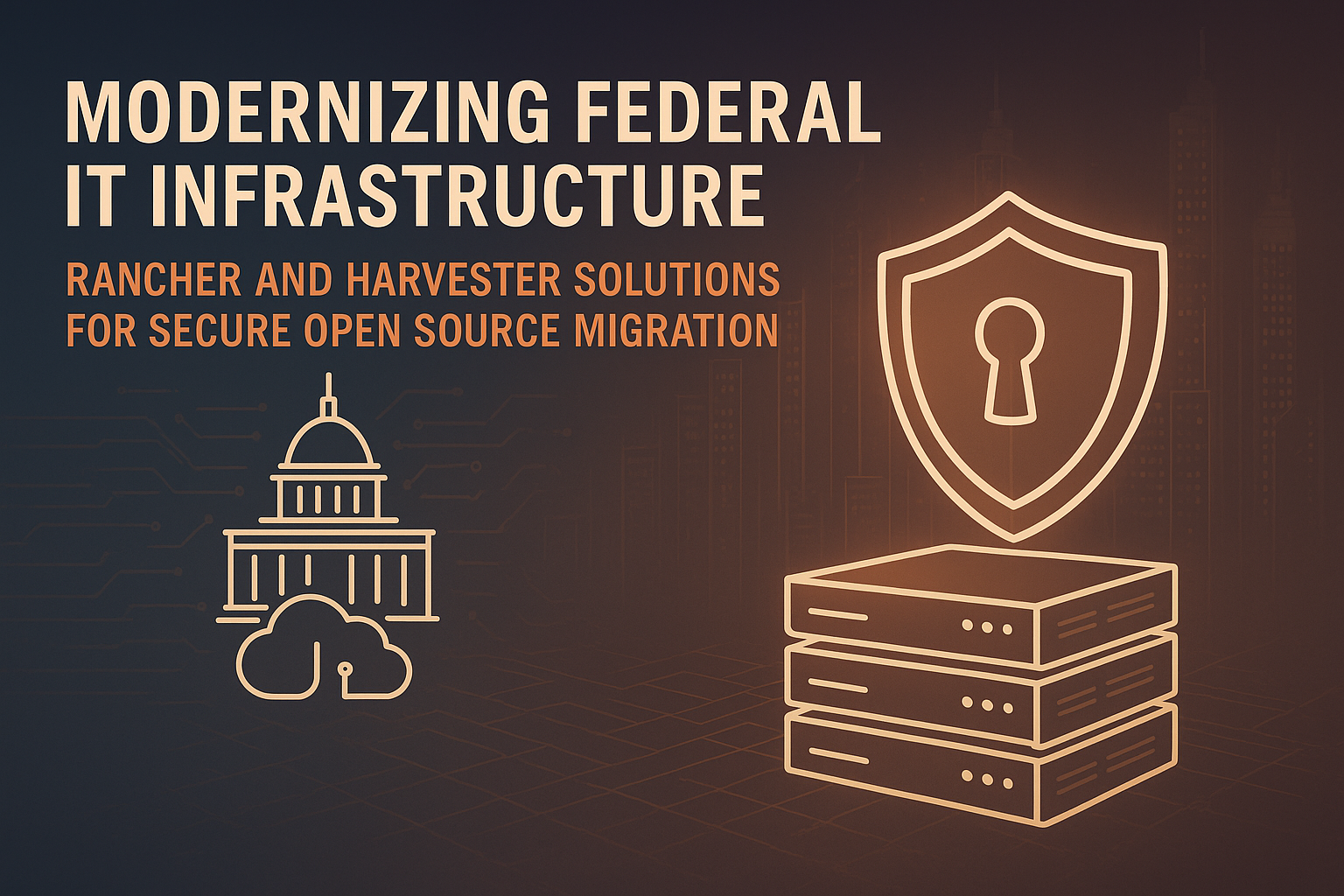Modernizing Federal IT Infrastructure: Rancher, SUSE and Harvester Solutions for Secure Open Source Migration
Cut Costs, Not Capabilities: Open Source Infrastructure for Post-VMware Federal IT

The federal technology landscape has undergone seismic shifts in recent years, pushing government agencies toward critical infrastructure decisions. The Broadcom acquisition of VMware has created unprecedented challenges for federal IT teams, with significant price increases and licensing uncertainty becoming major pain points across the government sector. As these pressures mount, Defense Department and federal civilian agencies are actively seeking alternatives that provide both technological advancement and fiscal responsibility.
The Growing Crisis in Federal Legacy Infrastructure
Traditional virtualization solutions that have underpinned government operations for decades are rapidly transforming from stable foundations into operational liabilities. These systems increasingly burden agencies with multiple compounding challenges that directly impact mission effectiveness:
Agencies face skyrocketing costs through escalating licensing fees and maintenance requirements, diverting critical funding from innovation initiatives. With the recent Broadcom acquisition, these financial uncertainties have only intensified, creating budgetary challenges for departments with fixed appropriations.
Legacy virtualization frameworks have evolved into overly complex systems requiring specialized knowledge for updates and maintenance. IT teams must dedicate excessive hours to manual processes that are error-prone rather than focusing on mission-critical initiatives. This technical debt accumulates precisely when agencies need maximum agility.
Perhaps most concerning for defense applications, traditional infrastructure creates significant security compliance gaps. As cybersecurity requirements become increasingly stringent, legacy systems struggle to implement security updates quickly enough to address emerging threats, potentially compromising sensitive data and creating audit concerns.
The proprietary nature of conventional virtualization technology has effectively created vendor lock-in across federal IT. Agencies find themselves constrained by proprietary technologies, losing operational control over their own infrastructure while being forced into costly upgrades on external timelines rather than mission requirements.
Harvester Government: Purpose-Built for Federal Requirements
Rancher Government Solutions (RGS) offers Harvester Government as a modern alternative specifically designed for federal needs. Unlike traditional virtualization platforms, Harvester Government represents a purpose-built hyperconverged infrastructure (HCI) product engineered to run both containers and virtual machines under a unified management framework.
"Harvester Government provides the stepping stones to migrate away from legacy solutions towards cloud native infrastructure," explains Camryn Carter, RGS Director of Product Management. "Running VMs alongside your container workloads gives you flexibility to optimize your resources, and RGS has handled security considerations like STIG compliance and encryption for you."
This platform's distinctive architecture uses Kubernetes as the universal orchestrator – a significant departure from traditional approaches that treat container workloads as secondary citizens. This architectural difference delivers several key advantages for federal deployments:
Air-Gap Capabilities for Classified and Tactical Environments
Harvester Government includes comprehensive air-gap functionality critical for disconnected government environments. The platform provides embedded documentation for disconnected knowledge management, encryption-at-rest options, and supports security image deployments in fully disconnected scenarios. These capabilities make Harvester ideally suited for classified networks, tactical deployments, and other environments where connectivity cannot be guaranteed.
For instance, in an air-gapped military network, technologies like ABOps (AlphaBravo Operations) can synchronize updates via "digital twins" – updates are prepared in environments with internet access, then resulting container images and configuration packages (all cryptographically verified) are securely transferred to the isolated environment. This methodology maintains security while ensuring disconnected Kubernetes clusters remain current – a critical requirement for defense applications.
Hardware Independence for Resource Optimization
Unlike proprietary solutions that require specific hardware configurations, Harvester Government offers hardware independence that maximizes existing investments. This platform can breathe new life into older servers that might otherwise sit unused in government data centers, creating significant value from existing hardware investments.
This hardware-agnostic approach enables agencies to maintain greater control over their procurement strategies and extend the useful life of current equipment – particularly valuable in federal environments where acquisition cycles can be lengthy.
The Security-First Architecture for Government Compliance
For agencies managing sensitive government workloads, Rancher Government enhances the upstream Harvester with Carbide™ services specifically designed for high-compliance and classified environments. These enhanced security capabilities include:
- FIPS-140-2 or 140-3 compliance at both operating system and Kubernetes layers
- US-soil built software assets with SLSA-3 Secure Supply Chain Compliance
- STIGATRON for Day 2 compliance monitoring and continuous validation
- Encryption-at-rest for virtual machine volumes
- Out-of-the-box DISA STIG compliance
- Kubewarden Security Policy Engine for policy enforcement
ABOps further reinforces this security paradigm with enforcement of STIGs, zero-trust architecture principles, and STIG-compliant Linux distributions with verifiable (signed) container images for all deployments. This comprehensive approach dramatically reduces the effort required for defense organizations to meet security accreditation requirements compared to traditional virtualization setups.
The implementation of STIGs (Security Technical Implementation Guides) within Kubernetes environments is streamlined through these tools, requiring minimal configuration changes while delivering maximum compliance – making security implementation remarkably efficient for government environments with strict authorization requirements.
Strategic Migration: Beyond Rip-and-Replace
Federal agencies often face concerns about disruptive technology transitions. Harvester Government addresses this challenge through a phased migration approach that respects existing investments rather than forcing immediate wholesale replacement.
Harvester Government can operate alongside existing virtualization environments during transition periods, supporting hybrid applications while agencies methodically migrate workloads at an appropriate pace. For VM workloads, the platform includes a VM Import Controller that connects to the existing virtualization environment and migrates virtual machines with their volumes intact, handling network mapping and allowing exported VMs to become base images for future deployments.
Container migration offers multiple paths depending on the current environment configuration, whether running Docker containers on VMs or managing Kubernetes clusters that can be imported to Rancher Manager. This flexibility prevents disruption while enabling progressive modernization.
Enhanced Operational Capabilities for Defense Applications
When paired with Rancher Government, Harvester Government delivers features that significantly enhance infrastructure capabilities compared to traditional approaches:
- Kubernetes cluster definition and management through standardized Helm charts
- Role-based access control (RBAC) with support for various authentication providers critical in defense environments
- GitOps/Continuous Deployment capabilities through Fleet for consistent configuration management
- Integrated logging and observability tools for comprehensive monitoring
The combination also offers Virtual Desktop Infrastructure (VDI) capabilities through partnership with Kasm Technologies, providing an infrastructure-agnostic, container-driven approach to VDI. This methodology hosts virtualized applications without requiring entire desktop environments, bypassing the need for specific Windows or Linux VMs and reducing resource consumption for faster provisioning.
Simplified Licensing Model for Predictable Budgeting
One of the most significant advantages for federal agencies is the straightforward licensing model. Since the Broadcom acquisition, VMware licensing has become increasingly complex and expensive with the consolidated approach. Government procurement officers report extended timelines just to receive quotations – an unacceptable situation in modern IT environments with compressed delivery schedules.
In contrast, Rancher Government Solutions offers a transparent pricing model:
- Harvester Government bills per server (up to 32 cores)
- Includes Rancher Management Server for managing Harvester clusters running VM workloads
- Rancher Suite is billed based on workload resources
- A single SKU includes full capabilities of Rancher for Kubernetes management, RKE2, Harvester Government, and comprehensive security tools
This simplified approach enables more accurate budgeting and faster procurement, aligning better with federal funding cycles and reducing administrative overhead.
The Federal Agency Experience
Government and defense organizations have emerged as early adopters of these technologies. Federal IT teams exploring alternatives to traditional virtualization cite tightening budgets and increased agility requirements as primary drivers. Rancher Government reports that Harvester has become exceptionally popular among federal customers seeking modern replacement options.
Department of Defense agencies with numerous legacy systems virtualized on traditional platforms find these systems increasingly expensive to maintain and difficult to update. Using Harvester, these organizations can sustain mission-critical legacy virtual machines while simultaneously advancing container modernization within a unified platform. In practical terms, applications that haven't been refactored from Windows VMs can continue running on Harvester while new microservices for those systems run in containers on the same infrastructure.
The broader transition reflects recognition that the cloud-native, container, and Kubernetes revolution has fundamentally transformed infrastructure possibilities. Harvester Government represents a more cost-effective, modern approach that uses Kubernetes as a universal control plane, enabling containers and virtual machines to operate side-by-side while facilitating seamless integration between legacy workloads and modernized components.
Looking Forward: Resilient Infrastructure for Evolving Missions
As federal agencies navigate an increasingly complex threat landscape while facing budget constraints, open-source solutions offer a path forward that balances security, flexibility, and fiscal responsibility. The purpose-built nature of platforms like Harvester Government and ABOps demonstrates how technologies can be tailored specifically for government requirements rather than adapted as afterthoughts.
For defense and intelligence organizations, these technologies create infrastructure resilience through their support for disconnected operations, supply chain security controls, and compliance automation. These capabilities directly address mission requirements while providing the foundation for continued innovation.
The freedom of choice offered by these open platforms enables federal agencies to maintain technology sovereignty – controlling their infrastructure destiny rather than being captive to vendor-driven roadmaps. This self-determination aligns perfectly with government mandates for open technology and represents a strategic advantage in an era where technology agility directly impacts mission success.
For federal IT leaders evaluating their virtualization strategy and considering open alternatives, the first step is often a comprehensive assessment of current infrastructure challenges followed by targeted proof-of-concept deployments in controlled environments. This measured approach allows teams to validate benefits while building the organizational expertise needed for broader adoption.
The technologies explored here represent not just alternatives to proprietary virtualization but a fundamentally different approach to infrastructure – one that embraces openness, security by design, and operational flexibility as core principles rather than optional features.

